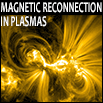Speaker
Mr
Bart Ripperda
(KU Leuven)
Description
Particle acceleration due to interacting tilt and kink instabilities in repelling current channels
B. Ripperda, R. Keppens
Centre for mathematical Plasma-Astrophysics, Department of Mathematics, KU Leuven
We present a numerical study where we use a combination of resistive magnetohydrodynamic
(MHD) and test-particle methods to analyze particle acceleration in two repelling current channels.
The initial MHD equilibrium configuration contains adjacent, oppositely directed, parallel current
channels, which consequently repel each other. The equilibrium is sensitive to an ideal
magnetohydrodynamic tilt instability in the plane. This leads to the creation of (near) singular
current sheets which in turn can accelerate particles. Our aim is to investigate how efficiently
reconnection accelerates charged particles and what kind of energy distribution they acquire.
In a three-dimensional setup, both current channels can be liable to an additional kink instability
(Keppens et al. 2014). The effects of having both tilt and kink instabilities on particle acceleration in
the violent, reconnection-dominated evolution are discussed.
With our open-source grid-adaptive MPI-AMRVAC software (Porth et al. 2014) we revisit the 3D
resistive MHD evolution of the tilt-kink instability for several realistic equilibriums which then yield
as background fields for a recently implemented test-particle module based on a guiding centre
approximation. We also analyze when the guiding-centre approximation is valid in an astrophysical
environment.
As a concrete astrophysical application, it is argued that interacting tilt-kink instabilities in repelling
current channels provide a novel route to initiate particle acceleration in solar coronal mass
ejections.
REFERENCES
Keppens, R., Porth, O., & Xia, C. 2014, ApJ, 795, 77
Porth, O., Xia, C., Hendrix, T., Moschou, S.P., & Keppens, R. 2014, ApJS, 214, 4
Primary author
Mr
Bart Ripperda
(KU Leuven)

